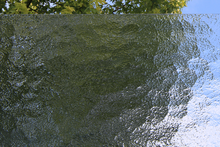Cathedral glass

Cathedral glass is a window glass with a rough surface that refracts the light shining through and thus offers partial privacy protection while the lighting function is retained. Often in the past it was thick, colored, and cast, and was widely used for church windows. During the Art Nouveau period , it was the preferred glass for glass domes, windows, furniture and room doors as well as for orangeries . Even today, handcrafted cathedral glass is an artistically used material for windows in representative surroundings.
The cathedral glass panes available in the glass trade today have two different sides: one is fairly smooth, the other has an irregular pattern that is reminiscent of flat waves. Such panes are used in windows that are supposed to let light through, but not a precise view from a distance - for example in bathroom windows or doors. Objects directly behind the glass can still be seen quite clearly, the further away they are from the glass, the more indistinct and shadowy they become.
Manufacturing
Traditionally, molten glass was poured onto a flat surface (wood or stone) and rolled flat, taking on the structure of the surface. Cathedral glass, which is now produced using traditional methods, is known as table cathedral glass . It can be recognized by its irregular structure and small air bubbles, which can hardly be avoided with this production method. The size of disks produced in this way is also limited. The structure of the glass can be taken over from the base or transferred to the glass by the rollers; it can also arise by itself due to the temperature gradient between the glass mass and the substrate and the consistency of the glass.
Today, cathedral glass - like other ornamental glass - is manufactured industrially on a rolling mill: the pattern is transferred to the glass by one or more rollers. At the end of the rolling train, slices of standard sizes are cut.
See also
Individual evidence
- ↑ Cathedral glass . In: Meyers Großes Konversations-Lexikon . 6th edition. Volume 10, Bibliographisches Institut, Leipzig / Vienna 1907, pp. 748–749 .
- ↑ schott.com: Cathedral glass . Archived from the original on September 5, 2011 ; Retrieved July 7, 2016 .
- ↑ Glashütte Lamberts - table cathedral glass
